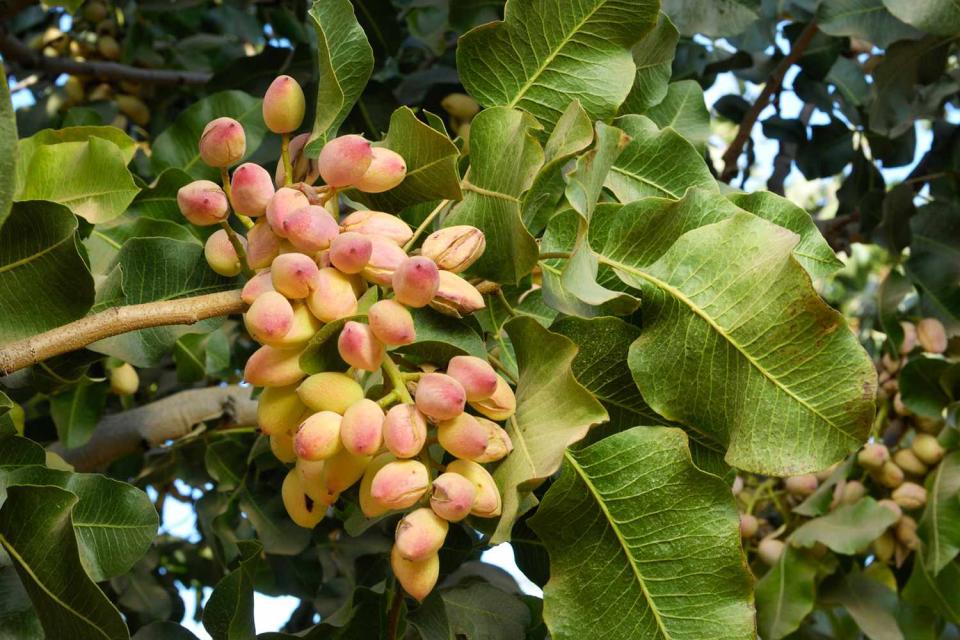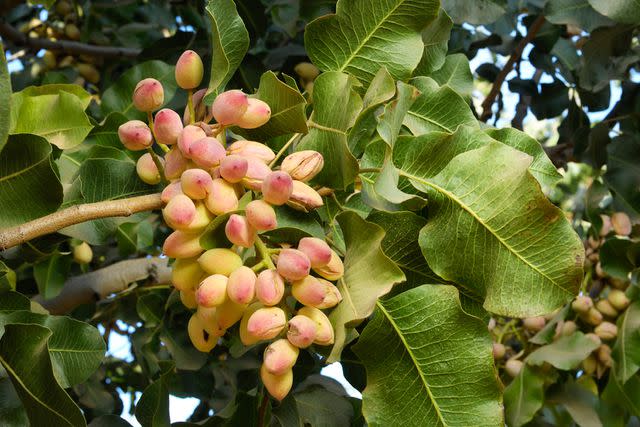How To Plant and Grow Pistachio Trees
In addition to producing tasty edible nuts, pistachio trees add a tropical feeling to the landscape with their large leaves.

GomezDavid / Getty Images
While technically called “drupes,” pistachio nuts have been a favorite food for thousands of years. When enjoying these crunchy, greenish nuts, you may have wondered if you could plant one and have it grow into a tree. While it's possible, you probably wouldn't want to because of the variability of the resulting tree. However, if you live in USDA Hardiness Zones 7-11, you still can try your hand at growing these amazing trees and harvest your own pistachios.
Aside from giving you pistachio nuts, the trees themselves are also attractive and fit well in the home landscape. With their wide, somewhat shiny leaves and ripening fruit taking on a pink tone, pistachios have a distinctive, almost tropical look to them. Unlike many fruit and nut trees, pistachio trees are either male or female, so you'll need to plant both for proper pollination. Fortunately, only one male is necessary for upwards of eight female trees.

GomezDavid / Getty Images
Where to Plant Pistachios
Pistachios thrive in warm, dry climates with hot summers and cool, wet winters. Regions in the United States with a Mediterranean climate such as California are best for growing pistachios.
At home, provide a full sun location with well-drained soil and access to water during the hot, dry summers. Although pistachio trees can be kept at a more manageable height through heavy pruning, if left alone, they will eventually need quite a bit of space and so choose a spot to plant your tree with its ultimate size in mind to avoid overcrowding. Male trees should be planted equidistant from all nearby female trees for best pollination.
How and When To Plant Pistachios
Pistachios grow in relatively mild climates and because of this, they can be planted throughout the year. However, the best time to plant pistachio trees is while they are dormant. Fruit and nut trees are often sold as bare root or pre-potted in late winter through early spring so that they can be planted in the ground before growth begins. Newly planted dormant trees will quickly begin to grow new roots and eventually new leaves as the weather begins to warm.
Planting pistachio trees is similar to planting most other types of trees. Begin by digging a hole twice the size of the root ball. Place the tree in hole and backfill soil into the hole ensuring that the tree remains upright and the existing soil line is maintained. If the tree is bare root, note the soil marking on the bark of your sapling and be sure to fully cover roots. Then water the tree thoroughly to remove air pockets and add additional soil as necessary.
Pistachio Care Tips
Light
Pistachios require full sun (8+ hours per day). Without full sun, trees will become leggy, not produce fruit, and be more susceptible to disease.
Soil and Water
Although pistachio trees can grow in most soil types, they do best in deep, free draining, loamy soils. Pistachio trees produce long taproots capable of reaching water deep underground, which makes them drought tolerant and capable of going through dry periods better than many other fruit and nut trees. Standing water and high humidity can lead to root rot and fungal diseases.
Temperature & Humidity
Hot, dry summers are necessary for pistachio trees to thrive and produce fruit. However, the trees are hardy down into the teens and can tolerate summer temperatures well over 100°F in the summer.
Fertilizer
Pistachio trees should be fertilized early in the season with a 12-12-17 or similarly formulated fertilizer and then again about midsummer until trees are established. Because pistachio trees bear in alternate years, mature trees can be fertilized less during off years.
Pistachios are heavy users of nitrogen and will become chlorotic (yellowing of leaves) without a steady supply of the nutrient. Soil testing can help determine other potential nutrient deficiencies.
Related: Why Are Nitrogen, Phosphorus, and Potassium in Plant Fertilizer?
How to Prune a Pistachio Tree
As with many fruit and nut trees, pistachios should be pruned in late winter or early spring before leaves have begun to appear. Begin yearly pruning by removing any dead, broken, or crossed branches. Any branches from below the graft should always be removed as well.
Pistachios can either be grown along a central leader or by the open center method, but because of their natural growth habit, pruning them into a vase shape isn’t necessary and they grow that way over time on their own.
Flowers and fruit are produced on one-year-old branches. Due to their year on/year off cycling, heavier pruning can be done on off years. To avoid infecting trees, always clean and disinfect pruning shears and saws prior to use.
Related: The 11 Best Electric Chainsaws for Trimming Limbs and Pruning Landscaping
Pests and Problems
Pistachio trees are highly susceptible to a variety of pests and diseases. Insects and fungal infections are common issues and environmental issues such as droughts, flooding, and poor soil increases the likelihood of infestation or infection.
The prevalence of diseases can be reduced by only watering around the base of the tree and by avoiding wetting the leaves and canopy of the tree. Localized humidity can be decreased by limiting the amount of nearby plants such as grasses, shrubs, and nearby trees. Good air circulation will help dry the ambient air as well.
How to Propagate a Pistachio Tree
The vast majority of pistachios are propagated by grafting. This technique attaches known varieties onto the rootstock of a variety or related species best adapted for the growing region it is to be planted. This allows for better control over the characteristics of the tree than a seed-grown tree. Pistachios can also be grown from seeds, but unlike with grafts,
Types of Pistachio Trees
By far the most common female cultivar is known as ‘Kerman’, but others exist as well. Newer female cultivars include ‘Golden Hills’, ‘Lost Hills’, and ‘Gum Drop’. Male cultivars should be selected to flower at the same time as female cultivars. Both ‘Peters’ and ‘Famoso’ are good pollinators for ‘Kerman’ while ‘Randy’ is a good pollinator for ‘Golden Hills’ and ‘Lost Hills’. For ‘Gum Drop’, use the male cultivar ‘Tejon’.
Frequently Asked Questions
Where can I buy a pistachio tree?
Pistachio trees can be found at local garden centers in regions where they grow well. Pistachio trees can also be ordered online from various sources, but local garden centers will have a better selection of trees best adapted to the local climate and conditions.
Can I grow my own pistachio trees from seed?
Pistachios can be grown from seed, but they usually turn out quite different from either parent plant, and not necessarily in good ways. And it can take upwards of 10 years before it can be determined whether they are male or female.
How long do pistachio trees live?
Pistachios are very long lived trees and under the right conditions can live to be over 300 years old! In cultivation, trees are usually removed well before they reach such old ages, however, since their productivity will gradually decrease over time. In the home garden or orchard, trees planted in full sun locations, given plenty of room, water, and fertilizer, can thrive for decades.
For more Better Homes & Gardens news, make sure to sign up for our newsletter!
Read the original article on Better Homes & Gardens.

